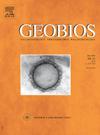Muroid rodents from the Lower Siwalik deposits near Ramnagar (Jammu and Kashmir), India: Biostratigraphic implication
IF 1.6
4区 地球科学
Q2 PALEONTOLOGY
引用次数: 0
Abstract
Various Lower Siwalik localities within the Ramnagar basin in Northwestern Jammu Himalaya (India) are known to yield diverse Miocene fossil mammals. However, as neither magnetostratigraphic ages nor radiometric dates are available, absolute temporal constraints on the fossiliferous horizons are missing. Some age diagnostic fauna recorded from the Ramnagar area has been utilized to date some fossil productive horizons such as Kalaunta 2 (K2), Dehari 1 (D1), Dehari 2 (D2), and Basi. In the present work murine dentition recovered from the Lower Basi (LB) site is reported. Based on the micromammalian assemblage at K2, D1 and LB, the fossiliferous horizons are placed in a composite stratigraphic column of the Ramnagar Basin. Variation of micromammalian content across these three fossiliferous horizons document dominance of cricetid rodents and absence of rhizomyine rodents at K2 site, abundance of rhizomyine rodents and scarcity of cricetid rodents at D1 site, and absence of cricetids rodents but presence of rhizomyine and murine rodents in the LB site.
印度Ramnagar(查谟和克什米尔)附近下Siwalik沉积物中的Muroid啮齿动物:生物地层意义
查谟-喜马拉雅(印度)西北部Ramnagar盆地内的各种Lower Siwalik地区已知产生各种中新世哺乳动物化石。然而,由于既没有磁地层年龄,也没有放射性测年,对化石层位的绝对时间限制是缺失的。从Ramnagar地区记录的一些年龄诊断动物群被用来确定Kalaunta 2 (K2)、Dehari 1 (D1)、Dehari 2 (D2)和Basi等化石生产层位的年代。在本工作中,报告了从下基底(LB)部位恢复的小鼠牙列。根据K2、D1和LB的微哺乳动物组合,将化石层位置于Ramnagar盆地的复合地层柱中。在这三个化石层中,小哺乳动物含量的变化表明,在K2位点,环状环状啮齿类动物占优势,而根瘤素类动物缺乏;在D1位点,环状环状啮齿类动物丰富,而环状环状啮齿类动物缺乏;在LB位点,环状环状啮齿类动物缺乏,但存在根瘤素类动物和小鼠类动物。
本文章由计算机程序翻译,如有差异,请以英文原文为准。
求助全文
约1分钟内获得全文
求助全文
来源期刊

Geobios
地学-古生物学
CiteScore
3.30
自引率
6.20%
发文量
28
审稿时长
6-12 weeks
期刊介绍:
Geobios publishes bimonthly in English original peer-reviewed articles of international interest in any area of paleontology, paleobiology, paleoecology, paleobiogeography, (bio)stratigraphy and biogeochemistry. All taxonomic groups are treated, including microfossils, invertebrates, plants, vertebrates and ichnofossils.
Geobios welcomes descriptive papers based on original material (e.g. large Systematic Paleontology works), as well as more analytically and/or methodologically oriented papers, provided they offer strong and significant biochronological/biostratigraphical, paleobiogeographical, paleobiological and/or phylogenetic new insights and perspectices. A high priority level is given to synchronic and/or diachronic studies based on multi- or inter-disciplinary approaches mixing various fields of Earth and Life Sciences. Works based on extant data are also considered, provided they offer significant insights into geological-time studies.
 求助内容:
求助内容: 应助结果提醒方式:
应助结果提醒方式:


